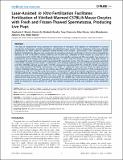Laser-Assisted In Vitro Fertilization Facilitates Fertilization of Vitrified-Warmed C57BL/6 Mouse Oocytes with Fresh and Frozen-Thawed Spermatozoa, Producing Live Pups
Author(s)
Qi, Peimin; Rosalia, Elizabeth K.; Discua, Allan R.; Mkandawire, John M.; Garcia, Alexis; Woods, Stephanie; Chavarria, Tony E; Fox, James G; ... Show more Show less
DownloadWoods-2014-Laser-assisted in vi.pdf (3.850Mb)
PUBLISHER_CC
Publisher with Creative Commons License
Creative Commons Attribution
Terms of use
Metadata
Show full item recordAbstract
The utility of cryopreserved mouse gametes for reproduction of transgenic mice depends on development of assisted reproductive technologies, including vitrification of unfertilized mouse oocytes. Due to hardening of the zona pellucida, spermatozoa are often unable to penetrate vitrified-warmed (V-W) oocytes. Laser-assisted in vitro fertilization (LAIVF) facilitates fertilization by allowing easier penetration of spermatozoa through a perforation in the zona. We investigated the efficiency of V-W C57BL/6NTac oocytes drilled by the XYClone laser, compared to fresh oocytes. By using DAP213 for cryoprotection, 83% (1,470/1,762) of vitrified oocytes were recovered after warming and 78% were viable. Four groups were evaluated for two-cell embryo and live offspring efficiency: 1) LAIVF using V-W oocytes, 2) LAIVF using fresh oocytes, 3) conventional IVF using V-W oocytes and 4) conventional IVF using fresh oocytes. First, the groups were tested using fresh C57BL/6NTac spermatozoa (74% motile, 15 million/ml). LAIVF markedly improved the two-cell embryo efficiency using both V-W (76%, 229/298) and fresh oocytes (69%, 135/197), compared to conventional IVF (7%, 12/182; 6%, 14/235, respectively). Then, frozen-thawed C57BL/6NTac spermatozoa (35% motile, 15 million/ml) were used and LAIVF was again found to enhance fertilization efficiency, with two-cell embryo rates of 87% (298/343) using V-W oocytes (P<0.05, compared to fresh spermatozoa), and 73% (195/266) using fresh oocytes. Conventional IVF with frozen-thawed spermatozoa using V-W (6%, 10/168) and fresh (5%, 15/323) oocytes produced few two-cell embryos. Although live offspring efficiency following embryo transfer was greater with conventional IVF (35%, 18/51; LAIVF: 6%, 50/784), advantage was seen with LAIVF in live offspring obtained from total oocytes (5%, 50/1,010; conventional IVF: 2%, 18/908). Our results demonstrated that zona-drilled V-W mouse oocytes can be used for IVF procedures using both fresh and frozen-thawed spermatozoa, producing live pups. The ability to cryopreserve mouse gametes for LAIVF may facilitate management of large-scale transgenic mouse production facilities.
Date issued
2014-03Department
Massachusetts Institute of Technology. Department of Biology; Massachusetts Institute of Technology. Division of Comparative Medicine; Koch Institute for Integrative Cancer Research at MITJournal
PLoS ONE
Publisher
Public Library of Science
Citation
Woods, Stephanie E., Peimin Qi, Elizabeth Rosalia, Tony Chavarria, Allan Discua, John Mkandawire, James G. Fox, and Alexis García. "Laser-Assisted In Vitro Fertilization Facilitates Fertilization of Vitrified-Warmed C57BL/6 Mouse Oocytes with Fresh and Frozen-Thawed Spermatozoa, Producing Live Pups." Plos ONE 9.3 (March 2014): e91892.
Version: Final published version
ISSN
1932-6203